
Vincent Willem van Gogh was a Dutch Post-Impressionist painter who is among the most famous and influential figures in the history of Western art. In just over a decade, he created approximately 2,100 artworks, including around 860 oil paintings, most of them in the last two years of his life. His oeuvre includes landscapes, still lifes, portraits, and self-portraits, most of which are characterised by bold colours and dramatic brushwork that contributed to the rise of expressionism in modern art. Van Gogh's work was only beginning to gain critical attention before he died from a self-inflicted gunshot at age 37. During his lifetime, only one of Van Gogh's paintings, The Red Vineyard, was sold.

Café Terrace at Night is an 1888 oil painting by the Dutch artist Vincent van Gogh. It is also known as The Cafe Terrace on the Place du Forum, and, when first exhibited in 1891, was entitled Coffeehouse, in the evening.

Starry Night, commonly known as Starry Night Over the Rhône, is one of Vincent van Gogh's paintings of Arles at night. It was painted on the bank of the Rhône that was only a one or two-minute walk from the Yellow House on the Place Lamartine, which van Gogh was renting at the time. The night sky and the effects of light at night provided the subject for some of van Gogh's more famous paintings, including Café Terrace at Night and the June, 1889, canvas from Saint-Remy, The Starry Night.
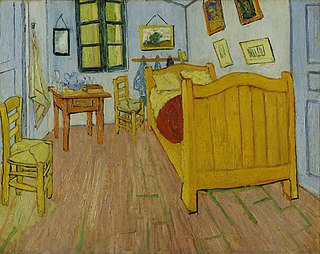
Bedroom in Arles is the title given to three similar paintings by 19th-century Dutch Post-Impressionist painter Vincent van Gogh.

L'Arlésienne, L'Arlésienne : Madame Ginoux, or Portrait of Madame Ginoux is the title given to a group of six similar paintings by Vincent van Gogh, painted in Arles, November 1888, and in Saint-Rémy, February 1890. L'Arlésienne means literally "the woman from Arles".
Vincent van Gogh lived during the Impressionist era. With the development of photography, painters and artists turned to conveying the feeling and ideas behind people, places, and things rather than trying to imitate their physical forms. Impressionist artists did this by emphasizing certain hues, using vigorous brushstrokes, and paying attention to highlighting. Vincent van Gogh implemented this ideology to pursue his goal of depicting his own feelings toward and involvement with his subjects. Van Gogh's portraiture focuses on color and brushstrokes to demonstrate their inner qualities and Van Gogh's own relationship with them.
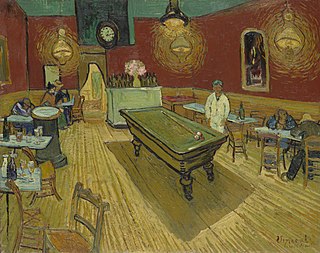
The Night Café is an oil painting created by Dutch artist Vincent van Gogh in September 1888 in Arles. Its title is inscribed lower right beneath the signature. The painting is owned by Yale University and is currently held at the Yale University Art Gallery in New Haven, Connecticut.
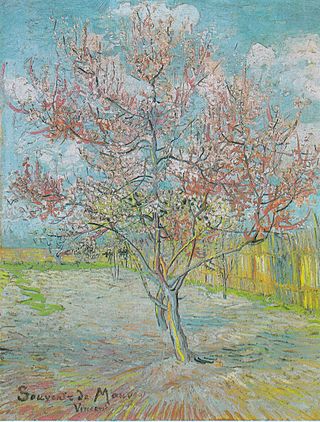
Flowering Orchards is a series of paintings which Dutch artist Vincent van Gogh executed in Arles, in southern France in the spring of 1888. Van Gogh arrived in Arles in February 1888 in a snowstorm; within two weeks the weather changed and the fruit trees were in blossom. Appreciating the symbolism of rebirth, Van Gogh worked with optimism and zeal on about fourteen paintings of flowering trees in the early spring. He also made paintings of flowering trees in Saint-Rémy the following year, in 1889.

The Langlois Bridge at Arles is the subject of four oil paintings, one watercolor and four drawings by Vincent van Gogh. The works, made in 1888 when van Gogh lived in Arles, in southern France, represent a melding of formal and creative aspects. Van Gogh used a perspective frame that he built and used in The Hague to create precise lines and angles when portraying perspective.

Landscape with Snow is a painting by Vincent van Gogh in 1888, believed to be one of the first paintings that he made in Arles. It is one of at least ten 1882 to 1889 oil and watercolor van Gogh paintings of a snowy landscape. The painting reflects the La Crau plains set against Montmajour and hills along the horizon.
Wheat Fields is a series of dozens of paintings by Dutch Post-Impressionist artist Vincent van Gogh, products of his religious studies and sermons, connection to nature, appreciation of manual laborers and desire to provide a means of offering comfort to others. The wheat field works demonstrate his progression as an artist from the drab Wheat Sheaves made in 1885 in the Netherlands to the colorful and dramatic 1888–1890 paintings from Arles, Saint-Rémy and Auvers-sur-Oise in rural France.
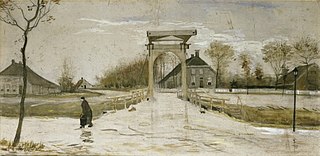
Drawbridge in Nieuw-Amsterdam is a watercolor created in November 1883 by Vincent van Gogh in Drente, The Netherlands.
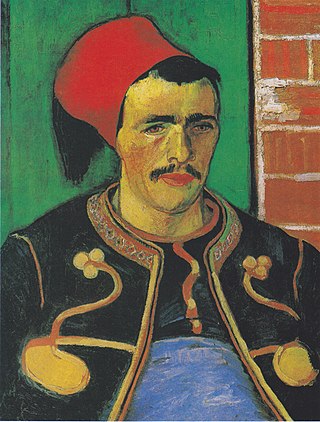
The Zouave is the subject of several sketches and paintings made by Vincent van Gogh in Arles, France in June 1888. The pieces range from close up oil painting portraits of the Zouave to full-body drawings. Van Gogh produced this collection of pieces during the period he spent in southern France, which many scholars regard as the zenith of his artistic career.Van Gogh nonetheless expressed frustration about his work during this time.
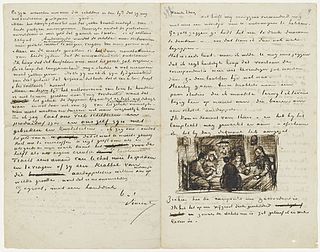
The Letters of Vincent van Gogh is a collection of 903 surviving letters written (820) or received (83) by Vincent van Gogh. More than 650 of these were from Vincent to his brother Theo. The collection also includes letters van Gogh wrote to his sister Wil and other relatives, as well as between artists such as Paul Gauguin, Anthon van Rappard, and Émile Bernard.

Sunset at Montmajour is a landscape in oils painted by the Dutch artist Vincent van Gogh on 4 July 1888. It was painted while the artist was at Arles, France and depicts a landscape of garrigue with the ruins of Montmajour Abbey in the background. The painting is 73.3 cm × 93.3 cm. For over 100 years, it was in a Norwegian industrialist's private collection and wrongly assumed to be fake, before being re-examined, authenticated and sold to its current private owner. The painting was temporarily on display from 24 September 2013 until 12 January 2014 as part of an exhibition at the Van Gogh Museum in Amsterdam.

Memory of the Garden at Etten (Ladies of Arles) is an oil painting by Vincent van Gogh. It was executed in Arles around November 1888 and is in the collection of the Hermitage Museum. It was intended as decoration for his bedroom at the Yellow House.

Boats du Rhône is a series of two sketches and three oil paintings, listed below, created by the Dutch artist Vincent van Gogh while living in Arles, France, during August, 1888.

Self-Portrait with Bandaged Ear is an 1889 self-portrait by Dutch Post-Impressionist artist Vincent van Gogh. The painting is in the collection of the Courtauld Institute of Art and on display in the Gallery at Somerset House. The painting includes inspiration from Japanese woodblock printing.
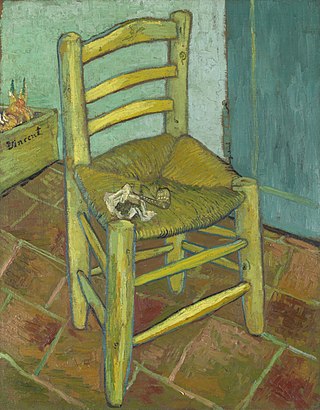
Van Gogh's Chair is a painting created in 1888 by Dutch artist Vincent van Gogh. It is currently held by the National Gallery, London.




















